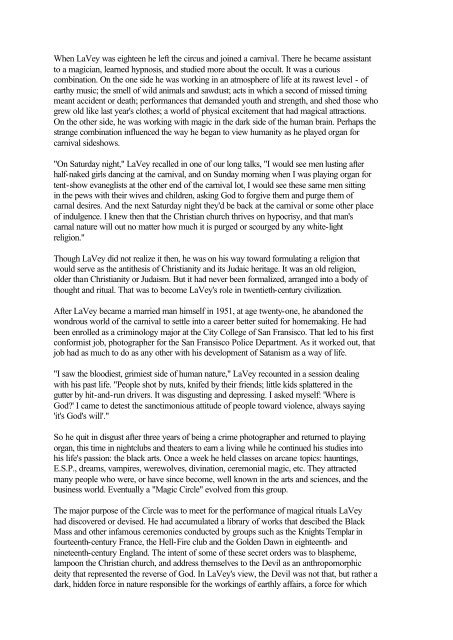o_19160673rcq1190b12mm8mi1nd9a.pdf
Create successful ePaper yourself
Turn your PDF publications into a flip-book with our unique Google optimized e-Paper software.
When LaVey was eighteen he left the circus and joined a carnival. There he became assistant<br />
to a magician, learned hypnosis, and studied more about the occult. It was a curious<br />
combination. On the one side he was working in an atmosphere of life at its rawest level - of<br />
earthy music; the smell of wild animals and sawdust; acts in which a second of missed timing<br />
meant accident or death; performances that demanded youth and strength, and shed those who<br />
grew old like last year's clothes; a world of physical excitement that had magical attractions.<br />
On the other side, he was working with magic in the dark side of the human brain. Perhaps the<br />
strange combination influenced the way he began to view humanity as he played organ for<br />
carnival sideshows.<br />
"On Saturday night," LaVey recalled in one of our long talks, "I would see men lusting after<br />
half-naked girls dancing at the carnival, and on Sunday morning when I was playing organ for<br />
tent-show evaneglists at the other end of the carnival lot, I would see these same men sitting<br />
in the pews with their wives and children, asking God to forgive them and purge them of<br />
carnal desires. And the next Saturday night they'd be back at the carnival or some other place<br />
of indulgence. I knew then that the Christian church thrives on hypocrisy, and that man's<br />
carnal nature will out no matter how much it is purged or scourged by any white-light<br />
religion."<br />
Though LaVey did not realize it then, he was on his way toward formulating a religion that<br />
would serve as the antithesis of Christianity and its Judaic heritage. It was an old religion,<br />
older than Christianity or Judaism. But it had never been formalized, arranged into a body of<br />
thought and ritual. That was to become LaVey's role in twentieth-century civilization.<br />
After LaVey became a married man himself in 1951, at age twenty-one, he abandoned the<br />
wondrous world of the carnival to settle into a career better suited for homemaking. He had<br />
been enrolled as a criminology major at the City College of San Fransisco. That led to his first<br />
conformist job, photographer for the San Fransisco Police Department. As it worked out, that<br />
job had as much to do as any other with his development of Satanism as a way of life.<br />
"I saw the bloodiest, grimiest side of human nature," LaVey recounted in a session dealing<br />
with his past life. "People shot by nuts, knifed by their friends; little kids splattered in the<br />
gutter by hit-and-run drivers. It was disgusting and depressing. I asked myself: 'Where is<br />
God?' I came to detest the sanctimonious attitude of people toward violence, always saying<br />
'it's God's will'."<br />
So he quit in disgust after three years of being a crime photographer and returned to playing<br />
organ, this time in nightclubs and theaters to earn a living while he continued his studies into<br />
his life's passion: the black arts. Once a week he held classes on arcane topics: hauntings,<br />
E.S.P., dreams, vampires, werewolves, divination, ceremonial magic, etc. They attracted<br />
many people who were, or have since become, well known in the arts and sciences, and the<br />
business world. Eventually a "Magic Circle" evolved from this group.<br />
The major purpose of the Circle was to meet for the performance of magical rituals LaVey<br />
had discovered or devised. He had accumulated a library of works that descibed the Black<br />
Mass and other infamous ceremonies conducted by groups such as the Knights Templar in<br />
fourteenth-century France, the Hell-Fire club and the Golden Dawn in eighteenth- and<br />
nineteenth-century England. The intent of some of these secret orders was to blaspheme,<br />
lampoon the Christian church, and address themselves to the Devil as an anthropomorphic<br />
deity that represented the reverse of God. In LaVey's view, the Devil was not that, but rather a<br />
dark, hidden force in nature responsible for the workings of earthly affairs, a force for which




